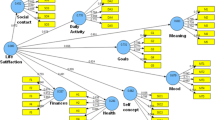Abstract
The objective of the study was to assess the internal consistency and test-retest reliability of selected scales from four national and provincial surveys used to study the health status of community-dwelling seniors. Items on physical impairment, psychological well-being, activities of daily living, chronic health problems, social support, and stressful life events were selected from these surveys and administered in a group of 1,054 seniors, aged 65 and over, living in Wellington County, Ontario. Each scale exhibited high internal consistency (Cronbach’s alpha ≥ 0.70) except for the stressful life events and social support scales. The intra-class coefficients (ρ) for all scales were > 0.80. In addition, almost all single items measures used in this study also exhibited high test-retest reliability (kappa > 0.80) except for measures of perceived health status (kappa = 0.69) and availability of help in crisis situation (kappa = 0.48).
Résumé
l’étude avait pour objectif d’évaluer la cohérence interne et la fiabilité test-retest d’échelles sélectionnées dans quatre enquêtes nationales et provinciales visant à étudier l’état de santé de personnes âgées vivant en communauté. Des éléments relatifs aux handicaps physiques, au bien-être psychologique, aux activités quotidiennes, aux problèmes de santé chroniques, au soutien social, et aux événements stressants ont été sélectionnés dans ces enquêtes et administrés à 1 054 personnes âgées de 65 ans et plus, vivant dans le comté de Wellington en Ontario. Chaque échelle a montré une cohérence interne élevée (alpha de Cronbach ≥ 0,70) sauf dans le cas des échelles relatives aux événements stressants et au soutien social. Les coefficients intra-classe (ρ) pour toutes les échelles étaient supérieurs à 0,80. En outre, pratiquement toutes les mesures relatives à des éléments uniques utilisées dans cette étude affichaient une fiabilité test-retest élevée (kappa > 0,80) à l’exception des mesures de la perception de l’état de santé (kappa = 0,69) et de la disponibilité d’aide en cas de crise (kappa = 0,48).
Similar content being viewed by others
References
McHorney CA. Measuring and monitoring general health status in elderly persons: Practical and methodological issues in using the SF-36 Health Survey. Gerontologist 1996;36(5):571–83.
Streiner DL, Norman GR. Health Measurement Scales: A Practical Guide to Their Development and Use. New York: Oxford University Press, 1989;104–27.
Statistics Canada, Canadian Centre for Health Information. National Population Health Survey. Ottawa: Ministry of Health Canada, 1992.
Statistics Canada, Housing, Family and Social Statistics Division. General Social Survey. Ottawa: Minister of Supply and Services Canada, 1991.
Statistics Canada, Ministry of National Health and Welfare. Ageing and Independence. Ottawa: Minister of Supply and Services, 1991.
Statistics Canada, Information, Planning and Evaluation Branch. Ontario Health Survey. Ottawa: Ministry of Health, 1989.
Stewart AL, Kamberg CJ. Physical functioning measures. In: Stewart AL, Ware JE Jr. (Eds.), Measuring Functioning and Well-being: The Medical Outcomes Study Approach. Durham, NC: Duke University Press, 1992;86–101.
Raina P, Waltner-Toews D, Bonnett B, et al. Influence of companion animals on the physical and psychological health of seniors: An analysis of a one-year longitudinal study. J Am Geriat Soc 1999 (in press).
Patrick DL, Bergner M. Measurement of health status in the 1990s. Annu Rev Public Health 1990;11:165–83.
Cronbach LJ. Co-efficient alpha in the internal structure of tests. Psychometrika 1951;16:297–334.
Fleiss JL. The Design and Analysis of Clinical Experiments. New York: John Wiley and Sons, 1986;1–32.
Cohen J. A coefficient of agreement for nominal scales. Educational and Psychological Measurements 1960;20:37–46.
Fleiss JL. Statistical Methods for Rates and Proportions 2nd ed. New York: John Wiley and Sons, 1981;188–236.
Fleiss JL, Cohen J. The equivalence of weighted kappa and the intraclass correlation coefficient as measures of reliability. Educational and Psychological Measurements 1973;33:613–19.
Landis JR, Koch GG. The measurement of observer agreement for categorical data. Biometrics 1977;33:159–74.
Krause N. Stressful life events and physician utilization. J Gerontol 1988;43(2):S53–S61.
Raina P. The Impact of Pet Ownership and Attachment on the Health and Health Care Use of the Elderly in Wellington County, Ontario [dissertation]. Guelph, Ontario: University of Guelph, 1995.
Boult L, Boult C, Pirie P, Pacala J. Test-retest reliability of a questionnaire that identifies elders at risk for hospital admission. J Am Geriatr Soc 1994;42:707–11.
Rubenstein L. Geriatric assessment: An overview of its impacts. Clin Geriatr Med 1987;3:1–15.
Author information
Authors and Affiliations
Corresponding author
Rights and permissions
About this article
Cite this article
Raina, P., Bonnett, B., Waltner-Toews, D. et al. How Reliable are Selected Scales from Population-based Health Surveys? An Analysis Among Seniors. Can J Public Health 90, 60–64 (1999). https://doi.org/10.1007/BF03404102
Received:
Accepted:
Published:
Issue Date:
DOI: https://doi.org/10.1007/BF03404102




